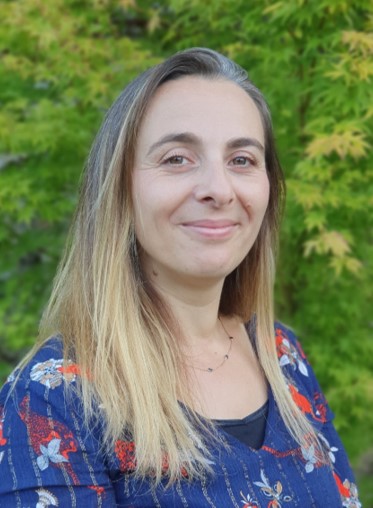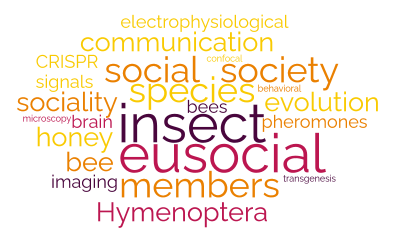
Maître de Conférences Université Paris-Saclay
Co-responsable du Pôle Evolution & Comportement
Tel: +33 1 69 15 49 73
julie.carcaud@universite-paris-saclay.fr
Recherche

- Evolution du traitement de l’information olfactive et gustative chez les Hyménoptères
- Traitement des phéromones dans le cerveau de l’abeille
La socialité est considérée comme l’une des principales transitions de l’évolution. Le niveau de socialité le plus avancé se trouve dans les sociétés d’insectes eusociaux. L’ordre des hyménoptères présente le plus grand nombre d’espèces eusociales et jusqu’à 8 origines indépendantes de l’eusocialité. Le succès des colonies d’insectes sociaux repose sur la capacité de tous les membres de la société à se comporter de manière bien organisée et en fonction du contexte. Mais comment le superorganisme de la colonie coordonne-t-il ses activités, permettant à chaque individu de savoir quelle tâche accomplir et à quel moment ?


L’organisation sociale des abeilles mellifères, l’espèce d’insectes eusociaux la plus étudiée, nécessite un mode de communication élaboré entre les membres de la colonie. Elles utilisent un moyen de communication sophistiqué grâce à un grand nombre de phéromones. Comment le cerveau de l’insecte social parvient-il à encoder une telle pléthore de signaux hautement significatifs et écologiquement pertinents ?
Mes recherches visent à répondre à cette question en utilisant des techniques de pointe telles que l’imagerie optique in vivo, les enregistrements électrophysiologiques, la transgénèse CRISPR-Cas9, la microscopie confocale et les expériences comportementales.
Figures réalisées par Rita Felix.
Publications
- Köhnen S, Ulbricht P, Sturm A, Carcaud J, Sandoz JC, Eltz T & Beye M (2025) The fru gene specifies male cooperative behaviors in honeybee colonies. Nature Communications, in press
- Andreu B, Mariette J, Delarue A, Larcher V, Hueber A, Touboul D, Montagné N, Chertemps T, Jacquin-Joly E, Carcaud J* & Sandoz JC* (2025) Identification of two odorant receptors tuned to alarm pheromone compounds in the honey bee Apis mellifera. Communications Biology, in press
- Mariette J, Carcaud J, Louis T, Lacassagne E, Sevais I, Montagné N, Chertemps T, Jacquin-Joly E, Meslin C, Marion-Poll F, Sandoz JC (2024) Evolution of queen pheromone receptor tuning in four honey bee species (Hymenoptera, Apidae, Apis). iScience 27(12):111243
- Bastide H, Legout H, Dogbo N, Ogereau D, Prediger C, Carcaud J, Filée J, Garnery L, Gilbert C, Marion-Poll F, Requier F, Sandoz JC, Yassin A (2024) The genome of the blind bee louse fly reveals deep convergences with its social host and illuminates Drosohila origins. Current Biology, https://doi.org/10.1016/j.cub.2024.01.034
- Carcaud J & Sandoz JC (2023) Editorial overview: More than behavior and neurons. Current Opinion in Insect Science, doi: 10.1016/j.cois.2023.101037
- Carcaud, J., Otte, M., Grünewald, B., Haase, A.*, Sandoz, J.C.*, Beye, M.* (2023). Multisite imaging of neural activity using a genetically encoded calcium sensor in the honey bee. PLoS Biology, 21(1): e3001984, 1-20.
- Bestea L, Paoli M, Arrufat P, Ronsin B, Carcaud J, Sandoz JC, Velarde R, Giurfa M, de Brito Sanchez MG (2022) Unraveling the motivational secrets of honey bee foraging during the COVID pandemic. iScience 25(4):104116
- Bestea L, Briard E, Carcaud J, Sandoz JC, Velarde R, Giurfa M, de Brito Sanchez MG (2022) The short neuropeptide F (sNPF) promotes the formation of appetititve visual memories in honey bees. Biology letters, 18: 20210520
- Bestea L, Paoli M, Arrufat P, Ronsin B, Carcaud J, Sandoz JC, Velarde R, Giurfa M, de Brito Sanchez MG (2021) The short neuropeptide F regulates appetitive but not aversive responsiveness in a social insect. iScience 25(1):103619
- Mertes M*, Carcaud J*, Sandoz, J.C. (2021). Olfactory coding in the antennal lobe of the bumble bee Bombus terrestris. Scientific Reports 11(1):10947 (*contribution égale)
- Bestea L, Réjaud A, Sandoz JC, Carcaud J, Giurfa M, de Brito Sanchez MG (2021). Peripheral Taste Detection in Honey Bees: What do Taste Receptors Respond to? European Journal of Neuroscience 54(2):4417-4444
- Mariette J, Carcaud J, Sandoz JC (2021). The neuroethology of olfactory sex communication in the honeybee Apis mellifera L. Cell and Tissue Research, 383: 177–194.
- Cholé H, Carcaud J, Mazeau H, Famié S, Arnold G, Sandoz JC (2019) Social contact acts as appetitive reinforcement and supports associative learning in honeybees. Current Biology 29(8): 1407-1413
- Bordiga P*, Cassel R*, Carcaud J, Simon F, Beraneck M, Le Gall A, Benoit A, Bouet V, Philoxene B, Besnard S, Watabe I, Pericat D, Hautefort C, Assie A, Tonetto A, Dyhrfjeld-Johnsen J, Llorens J, Tighilet B, Chabbert C (2019) Synaptic plasticity of vestibular primary synapses controls acute vestibular syndrome expression. (*contribution égale) Disease Models and Mechanisms 12(7)doi : 10.1242/dmm.039115
- França d Barros F, Carcaud J, Beraneck M (2019) Protocol for long-term visuo-vestibular mismatch in freely behaving mice. Journal of Visualized Experiments 144, e59135
- Carcaud J, Giurfa M, Sandoz JC (2018) Differential processing by two olfactory subsystems in the honeybee brain. Neuroscience 374:33-48
- Carcaud J, França de Barros F, Idoux E, Eugène D, Reveret L, Moore LE, Vidal PP, Beraneck M (2017) Long-lasting visuo-vestibular mismatch in freely-behaving mouse reduces the vestibulo-ocular reflex and leads to neural changes in the direct vestibular pathway. eNeuro 4(1):0290-16
- Juricek L*, Carcaud J*, Pelhaitre A, Riday TT, Chevallier A, Lanzini J, Auzeil N, Laprévote O, Dumont F, Jacques S, Letourneur F, Massaad C, Agulhon C, Barouki R, Beraneck M, Coumoul X (2017) AhR-deficiency as a cause of demyelinating disease and inflammation. Scientific Reports 7(1):9794 (*contribution égale)
- Carcaud J, Giurfa M, Sandoz JC (2016) Parallel olfactory processing in the honeybee brain: Odor learning and generalization under selective lesion of a projection neuron tract. Frontiers in Integrative Neuroscience 9:75, doi: 10.3389/fnint.2015.00075.
- Carcaud J, Giurfa M, Sandoz JC (2015) Differential combinatorial coding of pheromones in parallel olfactory subsystems of the honeybee brain. Journal of Neuroscience 35(10):4157- 4167
- Devaud JM, Papouin T, Carcaud J, Sandoz JC, Grünewald B, Giurfa M (2015) Neural substrate for higher-order learning in an insect: mushroom bodies are necessary for configural discriminations. Proceedings of the National Academy of Sciences USA 112(43): E5854-62
- Roussel E*, Carcaud J*, Combe M, Giurfa M, Sandoz JC (2014) Olfactory coding in the honeybee lateral horn. Current Biology 24 (5):561-567 (* contribution égale)
- Junca P, Carcaud J, Moulin S, Garnery L, Sandoz JC (2014) Genotypic influence on aversive conditioning in honeybees, using a novel thermal reinforcement procedure. PloS One 9(5):e97333
- Carcaud J, Hill T, Giurfa M, Sandoz JC (2012) Functional characterization of a dual olfactory pathway in the honeybee Apis mellifera. Journal of Neurophysiology 108:1106-1121
- Carcaud J, Roussel E, Giurfa M, Sandoz JC (2009) Odour aversion after olfactory conditioning of the sting extension reflex in honeybees. Journal of Experimental Biology 212:620-626
- Roussel E, Carcaud J, Sandoz JC, Giurfa M (2009) Reappraising social insect behavior through aversive responsiveness and learning. PloS One 4(1):e4197
